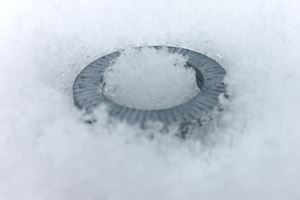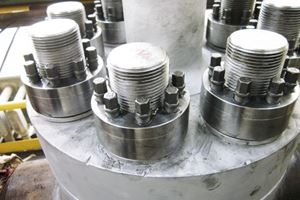The importance of temperature in bolting
What is the most common temperature range for bolts, and what are the consequences of exceeding it?
Bolts can be made of many different materials, the most common being carbon steel, alloy steel, and stainless steel. For high-temperature applications, different iron, nickel, and chromium-based alloys are used, such as Inconel and Waspalloy. The bolts made from carbon and alloy steel can be used from –50°C while the upper level depends on the plating temperature limit. Some common examples are listed in the table. In order to achieve higher operational temperature, nickel or chromium platings can be used as their temperature limit extends up to 590°C for nickel and 420–650°C for chromium. However, both methods are expensive and not widely used for fasteners.
| Bolt Material | Plating material | Temperature Interval | Temperature Interval | ||
| Min T (oC) | Max T (oC) | Min T (oF) | Max T (oF) | ||
| Carbon steel/alloyed steel | Oiled | -50 | 120 | -58 | 248 |
| Carbon steel/alloyed steel | Zinc plating | -50 | 230 | -58 | 446 |
| Carbon steel/alloyed steel | Cadmium | -50 | 110 | -58 | 230 |
| Carbon steel/alloyed steel | Phosphate | -50 | 200 | -58 | 392 |
| Carbon steel/alloyed steel | Heavy zinc | -50 | 200 | -58 | 392 |
| Carbon steel/alloyed steel | Heavy phosphate | -50 | 200 | -58 | 392 |
| Carbon steel/alloyed steel | Nickel | -50 | 590 | -58 | 1,094 |
| Carbon steel/alloyed steel | Chromium | -50 | 650 | -58 | 1,202 |
| Stainless steel | – | -120 | 320 | -248 | 608 |
| Onconel | – | -250 | 650 | -418 | 1,202 |
| Waspalloy | – | -250 | 870 | -418 | 1,598 |
Stainless steel bolts, available in a variety of alloys, normally require no protective coating and have a wider service temperature range than plain carbon or alloy steels. Depending on the alloy type, the temperature limit for stainless steel falls into the –120 to 320°C range.
Exceeding operational temperature range of the fasteners may have several consequences:
- Carbon steel and alloy steel become brittle at temperatures below –50°C.
- Exceeding the plating’s operating temperature can cause premature fastener failure due to hydrogen embrittlement as well as the loss of corrosion protection.
- The fastener’s strength properties decline with an elevation in temperature.
- Change in the clamping force due to different thermal expansion coefficients between the fastener and the joint.
- Creep and stress relaxation.
Like this article and want more?
Get engineering and bolting insights delivered straight to your inbox. Subscribe to our insights newsletter now!




